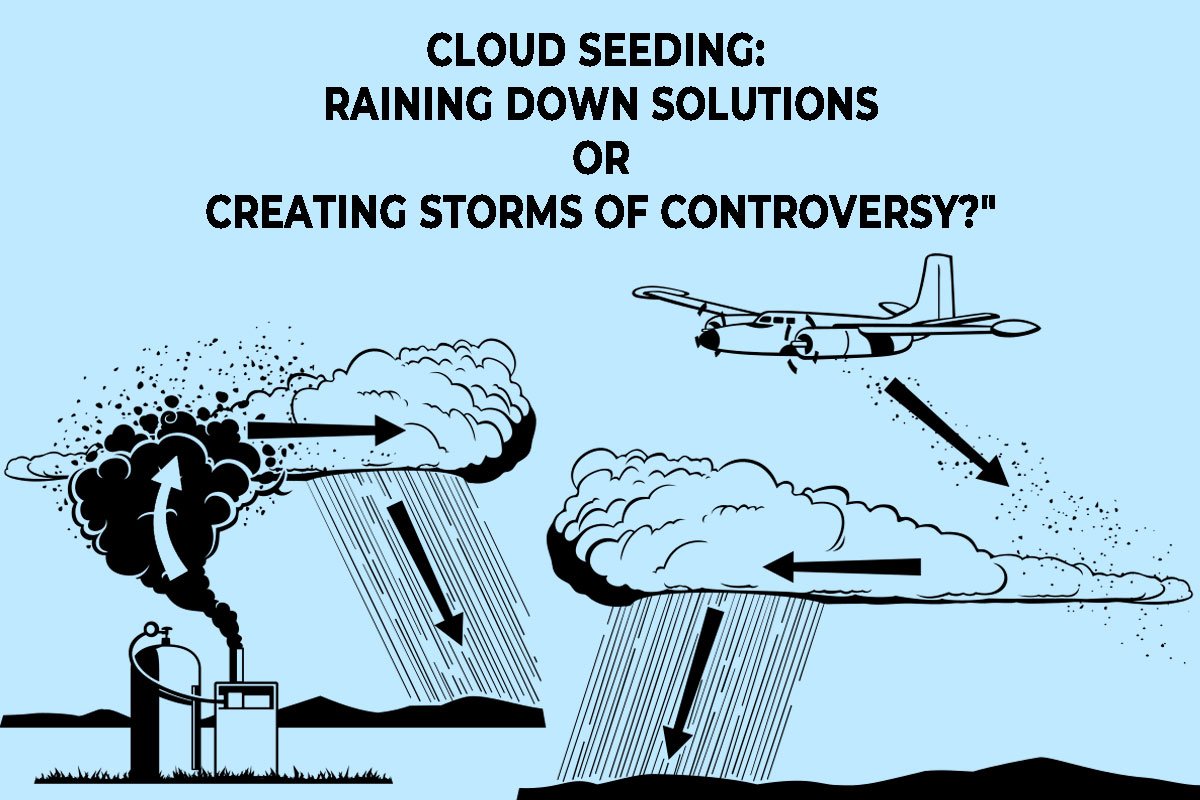Cloud seeding is a weather modification technique that aims to enhance precipitation, alleviate droughts, and manage water resources. This method involves introducing artificial substances into clouds to stimulate the formation of rain or snow. Despite its potential benefits, cloud seeding remains a controversial topic due to its environmental impact and the uncertainty surrounding its effectiveness. This article provides an in-depth look at the history, methods, applications, and challenges of cloud seeding.
History of Cloud Seeding
The concept of cloud seeding dates back to the 1940s when American scientist Dr Vincent J. Schaefer discovered that introducing dry ice into a cloud chamber could induce precipitation. This breakthrough led to the first successful cloud seeding experiment in 1946, where Schaefer used an aeroplane to disperse dry ice into a cloud, resulting in snowfall. Since then, numerous countries have explored and implemented cloud seeding programs to address water scarcity and other weather-related issues.
Methods of Cloud Seeding
There are two primary methods of cloud seeding: static and dynamic. Both methods involve the introduction of seeding agents into clouds to encourage the formation of ice crystals or raindrops.
- Static Cloud Seeding: This method involves dispersing seeding agents, such as silver iodide, potassium iodide, or compressed liquid propane, into clouds. These agents act as nuclei around which water vapour can condense, forming ice crystals or raindrops. Static cloud seeding is typically conducted using aircraft or ground-based generators.
- Dynamic Cloud Seeding: This method aims to enhance the vertical air currents within clouds, promoting the growth of larger ice crystals or raindrops. Seeding agents, such as hygroscopic materials like calcium chloride or table salt, are introduced into the lower regions of clouds. The increased weight of the particles causes them to fall, creating a downdraft that stimulates the growth of precipitation. Dynamic cloud seeding is usually performed using aircraft.
Applications of Cloud Seeding
Cloud seeding has been employed for various purposes, including:
- Increasing Precipitation: In regions experiencing water scarcity, cloud seeding can help increase rainfall or snowfall, replenishing water resources and alleviating drought conditions.
- Hail Suppression: By introducing seeding agents into storm clouds, the formation of large hailstones can be reduced, minimizing damage to crops, property, and infrastructure.
- Fog Dispersal: Cloud seeding can be used to disperse fog at airports, improving visibility and reducing the risk of flight delays or cancellations.
- Snowpack Augmentation: In areas reliant on snowmelt for water supply, cloud seeding can increase snowfall, ensuring adequate water resources during the warmer months.
- Reduced Air Pollution: Cloud seeding can reduce air pollution by encouraging rainfall to wash away pollutants and improve air quality.
These are some potential benefits of cloud seeding, lets some real-life examples of cloud seeding
Examples of cloud seeding
- United States: The Colorado River Basin has been using cloud seeding since the 1970s to increase snowpack and water resources in the region. The Wyoming Weather Modification Pilot Program, which ran from 2005 to 2014, aimed to evaluate the effectiveness of cloud seeding in increasing winter precipitation in the state’s mountainous regions.
- China: China has one of the largest cloud seeding programs in the world. The country has been using cloud seeding to address water scarcity, particularly in its arid northern regions. During the 2008 Beijing Olympics, China used cloud seeding to reduce air pollution and ensure clear skies for the event.
- United Arab Emirates: The UAE has been using cloud seeding since the early 2000s to increase rainfall in the arid desert nation. The country has invested heavily in cloud seeding technology and research, even launching a $5 million grant program in 2015 to fund innovative projects in rain enhancement science.
- India: India has been experimenting with cloud seeding since the 1970s to address water scarcity and drought conditions. The Indian state of Maharashtra conducted a cloud seeding project in 2015 to increase rainfall in the drought-stricken region. It was also conducted during the years 1983, 1984–87,1993-94 by Tamil Nadu Govt due to severe drought.
- Australia: The Queensland government initiated the Queensland Cloud Seeding Research Program in 2005 to investigate the potential of cloud seeding to increase rainfall and alleviate drought conditions. The program concluded in 2008, with mixed results regarding the effectiveness of cloud seeding in the region.
Challenges and Controversies
Despite its potential benefits, cloud seeding faces several challenges and controversies:
- Effectiveness: The effectiveness of cloud seeding remains a subject of debate, with studies producing mixed results. Some research suggests that cloud seeding can increase precipitation by 5-15%, while others find no significant impact.
- Environmental Concerns: The use of chemicals in cloud seeding raises concerns about their potential environmental impact and human health. For example, silver iodide, a common seeding agent, can be toxic to aquatic life in high concentrations.
- Legal and Ethical Issues: Cloud seeding can lead to disputes over water rights and the potential for “stealing” precipitation from neighbouring regions. Additionally, the intentional modification of weather raises ethical questions about the potential consequences and the responsibility of those involved.
- Cost: Cloud seeding programs can be expensive, requiring specialized equipment, aircraft, and trained personnel. The cost-effectiveness of these programs is often debated, particularly when the results are uncertain.
- Altering Precipitation Patterns: Cloud seeding can potentially affect precipitation patterns in nearby regions. By inducing rainfall or snowfall earlier than it would naturally occur, cloud seeding may reduce the amount of moisture available for precipitation in neighbouring areas. This could lead to imbalances in regional water resources and potentially disrupt the natural rainy seasons. It is essential to carefully consider the potential consequences of cloud seeding on a larger scale and monitor its impact on regional weather patterns to minimize any unintended negative effects.
Conclusion
Cloud seeding offers a potential solution to address water scarcity and other weather-related challenges. However, cloud seeding effectiveness, environmental impact, and ethical implications remain subjects of debate. As research continues, it is crucial to weigh the potential benefits against the risks and uncertainties associated with this weather modification technique.


